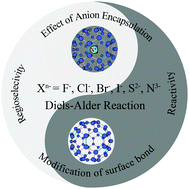Reactivity and regioselectivity in Diels–Alder reactions of anion encapsulated fullerenes†
Abstract
Encapsulation and surface chemical modification are methodologies to enhance the properties of fullerenes for various applications. Herein, density functional theory calculations are performed to study the Diels–Alder (DA) reactivity of anion encapsulated C60, including [X@C60]− (X = F, Cl, Br, or I), [S@C60]2−, and [N@C60]3−. Computational results reveal that encapsulated Cl−, Br−, I−, or S2− anions are located close to the center of the C60 molecule; however, encapsulated F− is displaced from the center. Encapsulated N3− bonds to the inner surface of the carbon cage, which leads to a negative charge transfer to the C60. In [N@C60]3−, C–C bonds near to the encapsulated N atom are more reactive. Our calculations reveal that encapsulated halogen or S anions decrease the DA reactivity because of the stronger closed-shell repulsion of the encapsulated anion. However, encapsulated N3− increases the DA reactivity. The higher distortion energy of the halogen- or S2−-anion encapsulated C60 leads to lower reactivity of the 6-5 bond. Opposite regioselectivity of the DA reaction with [N@C60]3− is attributed to distortion energy of the cyclopentadiene (CPD) moiety. The asymmetrical transition state geometry leads to a lower distortion energy of the CPD moiety.

- This article is part of the themed collection: 2017 PCCP HOT Articles


 Please wait while we load your content...
Please wait while we load your content...